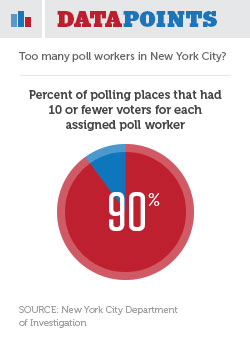Too Many Poll Workers in New York City?
An April New York City Department of Investigation report about the November 2011 general election found the Board of Elections (BOE) could have saved at least $2.4 million by reducing the number of inspectors by about half.

While some stakeholders had suggested the need for fewer poll workers prior to the election due to expected low turnout and many uncontested races, the BOE kept the city’s polling places fully staffed with 28,279 workers for 6,102 election districts.
The report found:
-
Approximately 90 percent of the more than 1,300 polling places had 10 or fewer voters for every poll worker assigned.
-
Average turnout was six voters for every poll worker.
-
At least 12 sites had more poll workers than voters, including one in Queens with 13 poll workers and nine voters.
-
Approximately 4 percent of the city’s 4.4 million registered voters — 170,000 people — cast ballots.











